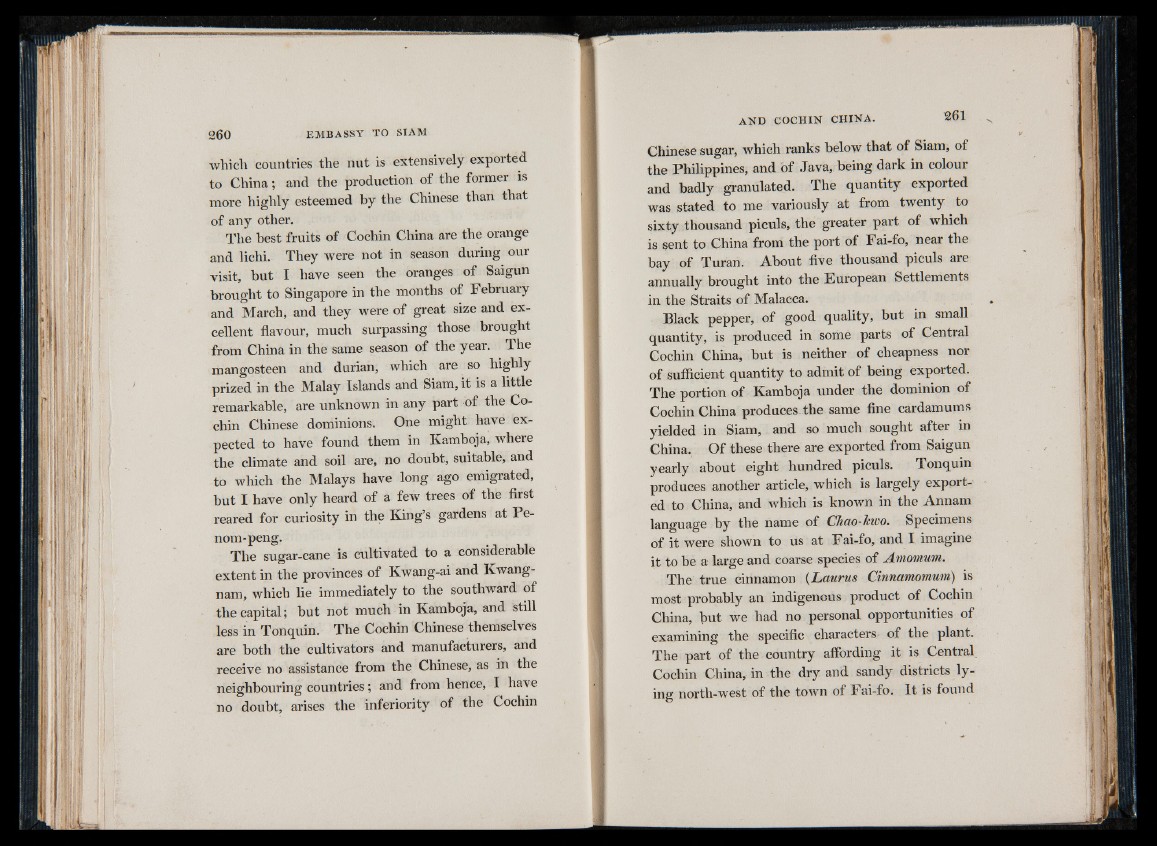
which countries the nut is extensively exported
to China; and the production of the former is
more highly esteemed by the Chinese than that
of any other.
The best fruits of Cochin China are the orange
and lichi. They were not in season during our
visit, but I have seen the oranges of Saigun
brought to Singapore in the months of February
and March, and they were of great size and excellent
flavour, much surpassing those brought
from China in the same season of the year. The
mangosteen and durian, which are so highly
prized in the Malay Islands and Siam, it is a little
remarkable, are unknown in any part of the Cochin
Chinese dominions. One might have expected
to have found them in Kamboja, where
the climate and soil are, no doubt, suitable, and
to which the Malays have long ago emigrated,
but I have only heard of a few trees of the first
reared for curiosity in the King’s gardens at Pe-
nom-peng.
The sugar-cane is cultivated to a considerable
extent in the provinces of Kwang-ai and Kwang-
nam, which lie immediately to the southward of
the capital; but not much in Kamboja, and still
less in Tonquin. The Cochin Chinese themselves
are both the cultivators and manufacturers, and
receive no assistance from the Chinese, as in the
neighbouring countries; and from hence, I have
no doubt, arises the inferiority of the Cochin
Chinese sugar, which ranks below that of Siam, of
the Philippines, and of Java, being dark in colour
and badly granulated. The quantity exported
was stated to me variously at from twenty to
sixty thousand piculs, the greater part of which
is sent to China from the port of Fai-fo, near the
bay of Turan. About five thousand piculs are
annually brought into the European Settlements
in the Straits of Malacca.
Black pepper, of good quality, but in small
quantity, is produced in some parts of Central
Cochin China, but is neither of cheapness nor
of sufficient quantity to admit of being exported.
The portion of Kamboja under the dominion of
Cochin China produces, the same fine cardamums
yielded in Siam, and so much sought after in
China. Of these there are exported from Saigun
yearly about eight hundred piculs. Tonquin
produces another article, which is largely exported
to China, and which is known in the Annam
language by the name of Chao-tcwo. Specimens
of it were shown to us at Fai-fo, and I imagine
it to be a large and coarse species of Amomum.
The true cinnamon (Laurus Cinnamomum) is
most probably an indigenous product of Cochin
China, but we had no personal opportunities of
examining the specific characters' of the plant.
The part of the country affording it is Central.
Cochin China, in the dry and sandy districts lying
north-west of the town of Fai-fo. I t is found